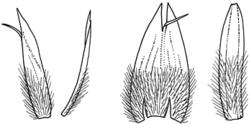Common name: Wiry Wallaby-grass
Plinthanthesis paradoxa (R.Br.) S.T.Blake APNI* 
Description: Caespitose perennial to 0.7 m high.
Leaves with ligule a ciliate rim with hairs to 1 mm long; blade rolled, scabrous, glabrous.
Inflorescence open, spreading, 5–16 cm long, to 7 cm wide; rachis slender, usually flexuous, smooth, often scabrous close to axils. Spikelets 5–7 mm long, gaping to 7 mm wide when mature, bisexual florets 3–5, often with 1 reduced floret above; pedicels slender, flexuous, 7–23 mm long, smooth, often scabrous towards axils. Glumes 5–7 mm long, 3-nerved, keel minutely scabrous, glabrous. Lemmas 3.5–4.5 mm long, 8-nerved, 2-lobed, awned from the sinus, lower half silky with hairs c. 0.5 mm long; lobes c. 1 mm long, subulate; awn c. 1 mm long, bent or straight. Palea subequal to lemma, 2-keeled, lower half silky with hairs c. 0.5 mm long.
Flowering: spring–summer.
Distribution and occurrence: Grows in swamps on sandstone.
NSW subdivisions: NC, CC, SC, CT, ST
Other Australian states: Vic.
Text by S. W. L. Jacobs & K. L. McClay
Taxon concept: Flora of NSW 4 (1993)
APNI* Provides a link to the Australian Plant Name Index (hosted by the Australian National Botanic Gardens) for comprehensive bibliographic data
***The AVH map option provides a detailed interactive Australia wide distribution map drawn from collections held by all major Australian herbaria participating in the Australian Virtual Herbarium project.
|


